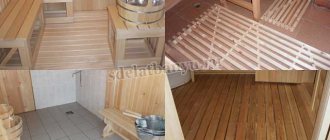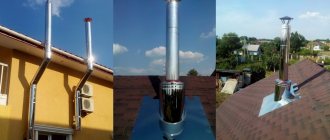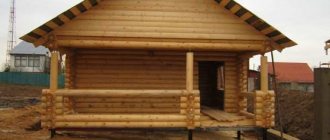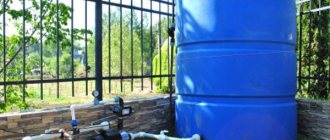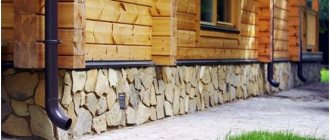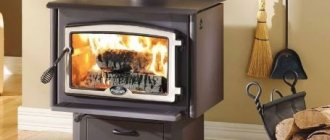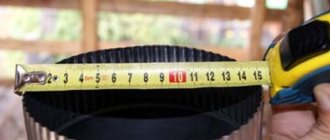One of the key elements of a modern bathhouse is the stove installed in it. And it is very important that the maximum possible removal of the resulting combustion products is ensured, and for this, the design of a high-quality chimney must be thought out and created in advance.
Doing an exhaust pipe to a bathhouse with your own hands is quite simple; it is important to be able to handle the tool and understand the meaning of the work being performed.
Photo of a pipe to a bathhouse, made in compliance with all the rules
Calculation method ↑
Scheme for determining the height of the chimney
Each detached house has a heating system with modern boilers running on solid, liquid or gaseous fuel, or with simple wood stoves. Each of these devices is invariably equipped with a structure for removing combustion products. At the same time, the height of the chimney plays an important role in the stable operation of all heating devices. An online calculator will help you determine this parameter.
One of the most important parameters ensuring the efficiency of the heating system is the height of the chimney relative to the roof ridge.
Any mistake or even error when calculating the chimney is fraught with serious problems. For example, the traction force is significantly reduced, which negatively affects the efficiency of the heating device.
An incorrectly chosen height of the chimney above the roof can cause the formation of a turbulence in the smoke exhaust channel, that is, reverse draft. This is fraught with smoke in the room with very serious consequences. Indeed, according to the laws of physics, good draft is stimulated by the wind, which is directed upward to the outlet of the smoke channel.
When he has to “go around” an obstacle that is too high, say, a ridge rib on a pitched roof or a multi-story building nearby, the air flows change their direction to the opposite. As a result, flue gases cease to be removed naturally.
The rules for selecting the height of the chimney above the roof are regulated by SNiP. Let us note the basic technical requirements that determine how high the chimney should be.
The height of the chimney above the roof is regulated by the distance of placement and the height of the solid structure that protrudes above the roof, for example, a parapet or roof ridge. If they are equal or for the structure it is greater, then the height of the chimney pipe is:
- not less than 50 cm - above the surface of a flat roof;
- not less than 50 cm, if the horizontal distance from it to the structure (roof ridge, parapet) is less than 1.5 m;
- greater than or equal to the height of the structure if this distance is between 1.5 and 3 m;
- level or above the line drawn from the ridge and 10˚ with the horizon line, provided that the distance from the chimneys (photo below) to the ridge is more than 3 m.
In any case, the mouth of the canal should be higher than the roof of higher buildings attached to the main one.
The height of the ventilation pipe located next to the chimney above the roof is assumed to be equal to the height of the latter.
It is recommended to increase the chimney until the head of the pipe is above the line, which is laid at an acute angle of 45˚ down from the top point. The most rational for pitched roofs is the location of the chimney, in which it is as close as possible to the ridge beam. Such channel localization ensures:
- the greatest distance between its mouth and the bottom of the grate;
- the skate does not block the path of air flow;
- guarantees minimal costs for the construction of a channel through which smoke is removed.
In cases where the horizontal distance required is no more than 1.5 m, you can use the usual method - build a model of the structure. To do this, use its diagram, made on an accessible scale.
- On the diagram, draw a line parallel to the base.
- In the place where the roof intersects with the pipe, without disturbing the scale, set aside 0.5 m.
- Through the resulting point, parallel to the first line, draw a second one. In this way, the minimum level at which the chimney head can be located is noted.
Finding the lower limit when the horizontal distance from the smoke duct to the ridge is in the range of 1.5–3 m is even easier. It is enough to lay a horizontal line across the top of the roof. This will be the minimum size of the outer section of the channel.
Professionals categorically do not recommend overestimating the size of the outer section of the smoke duct. If there is strong wind pressure, a tall pipe may topple over. If, due to some technical reasons, it is necessary to form a high section of the chimney above the roof, it is strengthened with guy wires.
This process is considered the most difficult, however, it is worth focusing on it, since such a design solution is not so rare. Let's say, houses that have large, exploitable extensions. In these cases, the heating unit is usually placed in such a way as to ensure heating of all living spaces.
Another example would be a complex structure in which a heating unit with a chimney is located in the center, but crosses the roof at a considerable distance from the ridge, for example, not far from the edge of the slope of the main structure.
Installation of a chimney is possible only if the distance between the expected level of the grate and the planned outlet is at least 5 m.
The minimum limit of this value in such cases is calculated in two ways: graphically and mathematically.
This method is based on geometric constructions similar to those given above. The diagram is drawn in compliance with the dimensions and proportions of the house on an accessible scale.
- In the prepared drawing, two axes of symmetry are marked: the ridge and the planned location of the chimney.
- A line is drawn horizontally through the top of the roof and, using a protractor, an angle of 10˚ is laid down from it.
- The designated line is continued until it intersects with the axis of symmetry of the smoke channel.
- The cut off segment gives the desired value.
- It must be measured and recalculated according to scale. The resulting value will be the real height value.
- It remains to check whether the resulting value satisfies building regulations.
The house design can be slightly adjusted if necessary. To do this, the chimney axis is gradually moved horizontally. Thanks to these simple actions, the optimal position of the smoke channel is determined.
This method is based on the use of trigonometric formulas. Calculations are performed in the following sequence.
- Prepare a drawing of the front part of the house on a convenient scale. For designers without much experience, the most acceptable is 1:100, when, when converting drawing units into the dimensions of a real building, 1 cm equals m.
- The axis of symmetry of the chimney is marked on the diagram.
- An auxiliary horizontal line is drawn through the top of the roof and continued until it intersects with the extension of the central axis of the chimney.
- As with the graphical method, a right triangle is constructed with an acute angle of 10˚ adjacent to the ridge edge.
- Knowing one of its legs, you can calculate the other using the formula a = b *tgα. In our case:
- a – distance from the ridge ridge to the mouth of the pipe;
- b – distance from the axis of symmetry of the house to the axis of symmetry of the chimney
- the angle α is an angle of 80˚, adding 10˚ to the right angle.
The presented methods are applicable only when calculating household chimneys that serve only one heating unit. For industrial boilers with a power exceeding 80 kW, or several heating devices, you should contact a professional.
We invite you to familiarize yourself with: Polypropylene bath fonts
The height of the chimney relative to the ridge on a pitched roof depends not only on the requirements of SNiP, but also on its internal shape, cross-section and other parameters, which, in turn, determine the efficiency of the heating device and its efficiency. To perform more detailed calculations, use online calculators, which can be found on specialized websites.
Graphics Computing
This method of determining the distance of the chimney from the ridge is considered the most difficult; it is used when the chimney is 300 cm or more away from the ridge.
Quite often the stove is installed almost in the center of a complex building in which the chimney crosses the roof at the extension site or very close to the edge of the main slope. If the distance from the grate level to the designed chimney outlet is 500 centimeters or more, then it is not possible to install it. In this case, it will be necessary to determine the height of part of the smoke exhaust duct in relation to the roof ridge.
To determine the minimum limit of the distance of the chimney from the ridge of the roof, two methods are used: graphical and mathematical.
Graphic constructions have some similarity with the above methods for determining the maximum value of the chimney height. A diagram of the house is drawn on a suitable scale with the indicated dimensions, taking into account the proportions.
A horizontal line is drawn at the top of the roof, and from it down, using a protractor, an angle of 10º is measured and marked. The place where the estimated axis of symmetry of the chimney intersects with a line drawn at an angle will indicate the value being determined. The resulting segment is measured, and the results on a scale are converted to real values.
If necessary, the project can be changed slightly by moving the chimney in a horizontal plane. Thus, you can find its optimal location. Remember that the distance between the roofing material and the short part of the smoke exhaust duct must be at least 50 cm. This is necessary for the arrangement of the otter and the possibility of protecting the roof with a metal roof covering.
To understand this, let's look at a diagram for calculating the height of the chimney.
The diagram clearly shows how to determine the height of the chimney depending on its location relative to the roof ridge
In it we have displayed all the most important aspects of accounting for chimney installation. The diagram shows the calculation of the chimney height in three options:
- If the distance between the pipe and the ridge is ≤ 1.5 m, then the chimney must be raised 0.5 m above the highest point of the house.
- If the distance from the chimney pipe to the ridge of the house is ≤ 1.5-3 m, in this case the height of the chimney above the roof will be equal to the height of the house. Or you can install the chimney flush with the ridge of the house.
- This option is most common. If the distance from the chimney to the ridge of the house is more than 3 m, the chimney may be located below the ridge of the house by 10° relative to the horizon.
Let's draw an imaginary line at 10° relative to the horizon. The letter Y is the distance from the ridge along the horizon to the chimney. In our case, this is 6 m. We denote the height of the house as Z. For us, this distance is also 6 m. The letter X will indicate the vertical distance from the end of the chimney pipe to the ridge of the roof.
The answer to the question of how to calculate a chimney is this: you need to calculate the tangent of the angle (TG) of the imaginary line and then use the formula. A right angle is 90°. Our imaginary line is 10°. We carry out simple calculations: 90 – 10 = 80°. Tangent 80° = 5.67. We calculate X. Using the formula X = Y/TG80. That is, in order to calculate the height of the chimney, we need to divide the distance from the ridge to the chimney by a tangent of 80°.
In our case, it is: 6m/5.67 = 1.058 m. Distance 1.058 ≈ 1 m 6 cm. So, X = 1.06 m. Now, to calculate the length of the chimney pipe, we need to subtract from the total height of the house (6 m) the resulting value of X. Let's call the length of the chimney the Latin letter T. Hence T = Z – X = 6 – 1.06 = 4.94 m. Roughly, the length of the chimney from the base of the house turned out to be 5 m.
This method involves drawing a building diagram with all the correct dimensions and proportions. A line is drawn from the ridge of the house at an angle of 10° relative to the horizon to the location of the proposed chimney until the lines intersect. The resulting distance is measured and converted to a real scale. You can adjust the diagram by moving the axis of the chimney horizontally. With these simple movements you can find the required location of the pipe.
There must be at least 50 cm between the roof covering and the edge of the pipe outside the building. If the stove heating fuel is solid, then add another 0.15 m to construct a protective structure, the material of which is metal tiles or corrugated sheets.
Types of systems
The design of sauna stoves includes 2 types of chimneys:
- Indigenous. They are organized next to the stove, using a special pipe for connection, through which the smoke goes into the main channel. One chimney can be used for 2-3 stoves. The main thing is that its internal diameter has the appropriate parameters, and the pipes from each heating device are located at different heights;
- Systems with a mounted pipe are mounted directly on the stove pipe and discharged through the roof. This chimney option is the most common for sauna stoves.
Classification of chimneys according to installation location includes 2 types:
- External. Their main part is located on the street and fixed to the wall using a bracket. They are not particularly recommended for baths, as they quickly cool down, losing precious heat.
- Internal. These are vertical structures with good traction, located inside the building.
Depending on the material used, chimneys are:
- Brick. A traditional look, characterized by labor-intensive masonry and high requirements for compliance with all parameters. They have a lot of advantages: durability, fire safety, strength, good thermal insulation and heat accumulation. Disadvantages include the roughness and angularity of the inner surface on which soot deposits accumulate;
- A metal chimney is faster to install and costs less. It has a perfectly smooth surface, but weaker heat-retaining characteristics;
- A combined version, including 2 parts: the lower one is made of brick, the upper one is made of a modern sandwich pipe. Allows you to organize neat, small passages that are easier to cover with heat-resistant material.
Conclusion
It is necessary to install a bath pipe carefully, not missing even small details, and if this process is being done for the first time, it is worth inviting an experienced craftsman to control and assist in the installation work. It is very important to comply with safety regulations and expert recommendations.
The video in this article contains some more details regarding the discussed topic.
The removal of smoke and gases from fuel combustion is carried out through the chimney pipe using air draft arising in the chimney. The draft force directly depends on the height of the chimney above the roof and the difference in air temperature outside and inside the duct. In the chimney, when the stove or boiler is operating, the temperature rises to 250–300ºС. After cooling the smoke masses, upon contact with the metal walls of the pipe, the temperature decreases and a constant draft occurs.
What should be the height of the chimney pipe?
Basic SNiP standards
So, what facts must be taken into account when calculating the height of ventilation and chimney:
- Distance to roof ridge.
- Roof design and thickness – gable, single-pitch, combined.
- Fire safety rules.
- Section.
- Organization of proper ventilation of the furnace room.
If you decide to do everything yourself, then knowledge of the technology for calculating height, diameter and other parameters will not hurt.
Angle from ridge to tip – 10 degrees
If the pipe is located at a distance of less than 50 centimeters from the ridge, then it is raised another half meter above the roof level. The diagram shows how easy it is to calculate the height, depending on the distance from the roof ridge.
A distance of one and a half to three meters is located at the level of the ridge, more than three meters is a slope of ten degrees down from the ridge, the required height is the intersection of the line of the angle of inclination and the top of the pipe.
The height of the pipe above the roof ridge is the most important calculation parameter. Good draft in the boiler and fuel economy depend on this value. When making calculations, one must be guided by the requirements recommended by the instructions for the boiler and SNiP41-01-2003, as well as SP 7.13130.2009 (basic building standards for heating and ventilation).
Another very important rule is that the length of the entire chimney, from the boiler grate to the point where the smoke exits, must be no less than 5 meters. For a flat roof - at least 50 centimeters.
Requirements for a chimney in an extension
The diagram shows that the chimney from the attic is determined by the intersection point of an angle of 45 degrees from the valley and a vertical line down from the end of the slope at a distance of 50 centimeters.
It is almost impossible to describe these calculations in words; the diagram is more informative. For example, I didn’t complicate the process. A full calculation and a clear plan costs only 2,000 rubles - it is carried out by design organizations; it seems to me that the price is quite reasonable.
The height depends on the roof structure
For pitched roofs, the height is calculated according to the standards, depending on the distance to the ridge. For flat roofs, the calculations are different.
The length of the chimney above a flat roof should not be less than 1 m 20 cm. If the pipe is higher, then it is necessary to install retaining clamps and guy wires made of strong wire for rigid, reliable fastening.
For roofs of complex multi-level structures, calculations are used taking into account height differences. But still, the highest point of the ridge is considered the base point. Multi-level structures must be calculated by specialists, since in this case many specific parameters must be taken into account.
The main problem with an incorrect chimney height is the risk of air turbulence. With strong gusts of wind, it can simply extinguish the fire in the boiler, which leads to very unpleasant consequences.
These conditions must be observed
There are quite a lot of fire safety requirements and all of them must be met:
- All structures adjacent to the pipe that may catch fire must be carefully insulated with asbestos sheets. Now fire safety requirements have changed, and many organizations do not allow asbestos, only galvanized iron. The same applies to chimneys.
- If the roof is made of flammable material and there are ventilation holes in the pipes, then the height should be increased by half a meter to prevent sparks from hitting the coating.
- A sheet of galvanized metal, no less than 1.5 x 1.5 meters in size, must be installed above and below the boiler.
- The distance from the chimney to the attic windows is at least two meters.
- The distance to tall trees and buildings is at least six meters.
Now, according to the changed standards, it is prohibited to install protective fungi on chimneys and ventilation outlets. The requirement is terrible, since birds and garbage clog the pipes every year, you have to constantly call a team to clean all this garbage.
The photo shows a simple table for determining the required section and height
For rectangular brick chimneys, the standard is 1x1.5 cm (minimum 10 square centimeters). Corners must be rounded.
The chimney is round in shape - the minimum diameter is 15 centimeters, but in Crimea they usually require 30-35 cm. Why, I cannot answer.
There is one more unpleasant nuance - there are no adapters for passing a round pipe through the roof, only for square ones. Therefore, you will have to order such an adapter individually from tinsmiths.
Calculation of the cross-section depending on the width (vertical table) and diameter (horizontal table) in millimeters
The height of the ventilation pipe above the roof according to SNiP should be calculated in principle in the same way as the chimney. The main requirement is one level in height of the ventilation and chimney pipes, if they are located no further than 3 meters from each other.
The diameter and dimensions of the ventilation must ensure ventilation of the boiler room space, and this depends on the volume of air contained in the room.
We invite you to familiarize yourself with: Do-it-yourself bathhouse roof, instructions for construction
The required volume of air entering a residential room heated by a boiler is three cubic meters per hour per square meter of area. In utility rooms (boiler rooms), this standard is at least 180 cubic meters per hour.
Formula for determining the ventilation cross-section
The formula for calculations is based on the ratio of the total area of the room to the cross-section of the ventilation duct. The height of the ventilation pipe above the roof is determined according to the same principle as for the chimney.
Anyone who believes that the external outlet of a device for removing flue gases, invariably formed during the combustion of any type of fuel, including gas, has little effect on the comfortable temperature in the house is deeply mistaken. The chimney pipe not only removes the resulting smoke and flue gases, but also has a significant impact on the performance of heating units, their efficiency and energy consumption.
Important! Both the height of the pipe and its internal diameter, when correctly calculated using a calculator, guarantee the normal operation of heating units and their safety - both in terms of fires and for human health. After all, such devices prevent carbon monoxide from entering residential premises.
To make a competent and correct calculation of the chimney, you need to consider the following points:
- Depending on the fuel used, you need to choose the material from which the chimney will be built. After all, flue gases from different energy carriers have different temperatures.
- The height of the chimney above the roof, its internal cross-section and design features directly affect the functionality of the heating equipment of your home. The discrepancy between these parameters can lead to incorrect functioning of boilers and furnaces, up to and including their complete reconstruction.
- Various appliances that produce flue gases require ventilation for their operation. Since it is unprofitable to build a separate drainage channel for each such system, most often they are combined in one design.
Naturally, not everyone is able to make competent technical calculations. But you can use an online calculator or entrust the calculation procedure to heating specialists.
This parameter primarily depends on:
- Depending on where exactly on the roof the chimney outlet will be located relative to the ridge.
- From the angle of the roof slope.
- From the presence of tall trees and buildings in the immediate vicinity of the pipe.
- From the wind rose and the strength of wind flows in a particular area, as well as from the average annual height of snow cover.
If the pipe exits the roof at a distance of less than half a meter from the ridge, then the minimum height of the chimney above its level should be 50 cm. This arrangement of the chimney is considered optimal, since in this case a significant amount of materials required for the construction of the smoke exhaust structure is saved.
In addition, in such a place less snow accumulates in winter, which reduces the risk of leaks when it melts in the spring and during thaws. Calculating the height of the chimney relative to the ridge, even using a calculator, is based on the requirements of SNiP41-01-2003 and SP (building rules) 7.13130.2009, as well as on the recommendations of the heating device manufacturer.
General provisions
Diagram of channels leading to the roof of the building
- The length of the pipe from the grate to the outlet must be at least 5 meters. If the roof has a flat structure, then the height of the pipe is at least 50 cm.
- On pitched roofs, if the pipe is located at a distance from the ridge of up to 1.5 m, its height should be at least 50 cm relative to the last or enclosing parapet. If the pipe is located within 1.5–3 meters from the ridge, then its height cannot be lower than it or the parapet. When the pipe is located more than 3 meters from the ridge line, its minimum height is determined by drawing a line at an angle of 10 degrees relative to the horizon.
- If there are taller buildings nearby and the heating is done with wood, then the height of the pipe is taken to be higher than the roof of the adjacent buildings.
- Ventilation ducts that go to the roof of the building and are located in close proximity to the chimneys must be the same in height as them.
In addition, there are a number of recommendations for the location of chimney pipes and their installation.
It is undesirable to place chimney pipes near attic windows so that random gusts of wind do not carry smoke or carbon monoxide into the attic space, if it is residential. It is also not recommended to build exhaust pipes and ventilation ducts in valleys to avoid the formation of a snow pocket.
When removing the outer part of the chimney, you should not rigidly fasten it to the roof itself and the rafter system, since if the pipe is damaged by wind or other natural forces, the entire roof structure will be damaged.
Chimney materials
Before purchasing materials, you need to determine the structural features of the chimney.
Brick system
The construction is made of heat-resistant brick using a special dry mixture or oven clay. In addition, you may need material to create a fungus over the pipe.
Before purchasing material for the manufacture of a metal chimney in a bathhouse, it is necessary to draw up its exact diagram with the detailed location of all corners and turns of the pipe.
You will also need 2 iron sheets with holes corresponding to the diameter of the pipe. They are fixed on the ceiling of the bathhouse and on the floor of the attic. You will also need a heat-resistant material that will be secured around the pipe at the point where it exits into the wooden attic.
To create waterproofing around the chimney on the roof, you need to prepare a sealant or a special rubber seal.
When purchasing iron chimney pipes, you need to decide on their cross-section. Basically, it depends on the power of the stove, but for most bath options this parameter is 15-20 cm. You should not take a diameter that is too large, as it will not retain heat well. And if it’s too small, it won’t create the draft necessary for removing smoke. Whatever it is, the cross-section of the pipe should not be less than the diameter of the outlet pipe of the heating structure.
There are a number of other requirements for the elements of a chimney in a bathhouse:
- The minimum pipe height is 5 m. Neglecting this requirement may result in deterioration of traction. The exact value is calculated depending on the location of the pipe on the roof. In any case, it should rise above the ridge by at least half a meter. The ideal height from the ridge is 1.5 m, but this is not necessary;
- The minimum thickness of the metal used to create the pipe is 1 mm;
- If it is planned that the chimney system will be equipped with a hot water tank, then it must be reflected in a previously drawn up diagram. It is better if the tank is made of stainless steel.
Traction concept
Do not allow dripping condensation to form in the chimney, which gradually destroys the inner surface of the channel. This especially happens in the cold season , when there is a significant decrease in outside air temperature. The process of moisture droplets falling out in the chimney also causes disruption of normal draft. A decrease in the rate of passage of gases from combustion products occurs not only with the internal formation of condensation; the draft force is affected by the humidity of the outside air, which can have different values depending on the weather. A deflector installed above the chimney will help you ignore this indicator.
To find out whether there is draft in the chimney pipe , you should bring a match or a strip of paper to the boiler firebox with the door open and the vent half open. The fire of the match should deviate towards the firebox, the strip of paper should also sway towards the mouth of the furnace.
If the opposite happens, then this indicates the occurrence of reverse draft, which prohibits the start of heating.
Safety first
The temperature of the chimney in the bathhouse can rise to critical limits, so the organization of the system must comply with fire safety requirements:
- Connections of individual parts of the pipe must be strictly sealed;
- The places where the pipe passes through the ceiling are insulated from wooden elements with fireproof material (sand, asbestos, expanded clay);
- The pipe exit through the roof is treated with waterproofing designed to protect the sheathing from moisture.
We suggest you read: The cheapest foundation for a bathhouse
Head design rules
What functions are attributed to this device:
- protecting the chimney from rain, snow, leaves and foreign objects, reducing the impact of strong gusts of wind;
- thanks to protection from moisture and wind, increased draft in the smoke channel;
- roof decoration.
If the roof serves for the outlet of several pipes , then identical heads will serve as a decorative detail and combine all the outlets into one ensemble. There are various designs of caps; they are intended for ventilation ducts and chimneys, but their protective functions are necessary for the normal operation of the heating system.
How does the cross-section of a chimney affect its height?
Round chimney
In addition to the fact that the height of the smoke exhaust ducts is regulated by the requirements of SNiP, its cross-section and internal shape must be taken into account. These parameters also affect the normal functioning of heating devices and their efficiency.
According to the laws of physics, warm air - in our case, flue gases - rises when heated. And the closer it is to the exit, the more it cools, resulting in the formation of draft. Accordingly, a large chimney cross-section, it would seem, should create better draft. But in reality this is not always the case.
What is the expected way out? You can increase the height of the pipe and reduce its cross-section. In this case, the draft will be so great that it can lead to a loss of efficiency of the heating boiler or stove. After all, the supply of cold air from below will be increased, due to which the heating of the heating device itself will be insufficient. This means more fuel consumption and warm-up time will be required.
If the chimney is high and the internal diameter is insufficient, the draft will also be insufficient for normal operation of the device. In addition, smoke and carbon monoxide may be released into the room. To prevent this from happening, and to ensure that the heating devices operate at full efficiency and productivity, it is necessary to calculate all parameters using a calculator or inviting specialists.
Some more tips
In addition to height, the draft force is influenced by the shape of the internal section of the chimney. An oval passage is considered optimal, since as you gain altitude, the smoke begins to twist into a spiral and nothing prevents it from accelerating. Square and rectangular sections themselves become an obstacle due to the internal corners, so the surface must be smoothed as carefully as possible. Some masons select and lay bricks with the smooth side inward, while removing the mortar buildup.
Another important point is the size of the chimney diameter. Oval passages are made according to the size of one tenth of the area of this firebox parameter. Square pipes require an area size of one fifteenth of the firebox area. The general rule for all smoke ducts is that their diameter should not be less than the width of the upper exit from the ash pit.
In addition to the height of the pipe relative to the ridge, you should take into account its height from the location of the ventilation ducts . Ventilation located nearby requires raising the height of the chimney by 20–25 cm from its horizon. If there is insufficient draft in the pipe, then the method of increasing the pipe height is used. But at the same time, you should remember the rule of relevance, that is, you should not make the height too large or insufficient.
Recommendations
It happens that in addition to heating equipment, a house has a fireplace or a gas heater, and each of them requires its own smoke exhaust channel. Naturally, no one will build a chimney for every appliance. In this case, a combined chimney with several channels is made, taking into account the power of each device, the type of fuel and the amount of combustion products produced.
Such structures have several advantages:
- stable operation of all devices;
- saving living space;
- saving money and labor costs.
The calculation of such a structure must be entrusted to professionals.
How to calculate the height of the chimney above the roof?
The pipe in the bathhouse is not the subject of complex calculations; it can be selected using ready-made diagrams; the main thing is to know the power of the installed stove.
There are standards that must be adhered to; the parameters depend on the power of the product. Rectangular and square chimneys are calculated in proportions: 140x140 mm is used up to 3.5 kW, respectively 140x200 mm 3.5-5.2 kW, 140x270 mm 5.2-7.2 kW.
If the chimney is round, then it should not be smaller than the exit point from the stove opening, more is acceptable, less is not.
It is easy to calculate the parameter by following certain rules that will help you.
The pipe area must be at least 8 cm² for each kW of power. You can do the calculations yourself; a “bright head” and the formula for the area of a circle will help with this.
The height of the chimney determines the safety for you and your loved ones. If, when operating gas boiler equipment, the chimney plays the role of a smoke exhaust channel, with low-temperature combustion products, then for solid fuel boilers, stoves and fireplaces no compromises are allowed.
Calculation of the smoke exhaust pipe from its location
The fact is that if the parameters of a smoke exhaust pipe or channel are incorrectly calculated, there is a risk of serious poisoning by combustion products, or a fire may even be caused by unburned fractions or fragments of ignited soot.
The following rules should be followed:
- The height of the chimney is not the only parameter that affects the performance and safety of the heating system, with a gas or solid fuel boiler as a heating device. Chimney design begins with determining the operating parameters of the heating system. This means that the complex for calculating the boiler room must take into account these factors as well. At this point, the owner of the premises must decide on the type of fuel used (gas, pellets, firewood or peat), and, with the help of a specialist, determine the thermal power of the boiler. decide on the types of radiators or convectors. There are a lot of questions, however, missing a point can have a detrimental effect on the performance of the entire heating system. For example, many novice home builders are mistaken that all chimneys are the same. This is wrong. A brick chimney is suitable for heating with solid fuel, such as wood, but it is not intended for heating premises with a gas boiler.
- With regard to the operating parameters of boilers, the height of the chimney can also affect the final efficiency during heating. Do not forget about the cross-section of the pipe - the diameter affects the minimum and maximum volume of combustion products passing through, provided by natural draft.
- The process of calculating the chimney of a fireplace or solid fuel boiler may require additional calculations and measurements. This is due to the use of one smoke channel by several devices in the boiler room at the same time. Amateur action can lead either to unforeseen heating parameters or even to dire consequences.
- There is no chimney system that could be universal for any type of fuel, boiler equipment and used as a standard solution. In this regard, the most difficulties arise for developers and owners of private houses and cottages.
Height above roof
The height of the end of the chimney from the ridge or roof must fit into the regulations calculated in advance. If it is located at a distance of 1.5 meters from the ridge, its height is allowed from 0.5 meters. The farther from the vertical line of the ridge, the higher the end of the chimney should be located. At a distance of 3 meters, the chimney should be almost completely aligned with the maximum height of the ridge.
Calculation of the minimum chimney height
Do not neglect such an important stage of housing construction as chimney design. Entrust the correct calculations to specialists, and you will receive the optimal parameters for height, diameter and type of material used for chimneys for various boilers. These numbers hide complex laws of aerodynamics, thermodynamics and materials science.
Tags: bathhouse, height, chimney, roof, pipe
« Previous entry
Summarizing the above
We understand how to calculate the height of the pipe above the ridge. All that remains is to comply with some requirements when calculating and constructing the system in order for it to work stably and reliably:
- the height of the chimney above the roof must meet the necessary rules;
- the chimney system should be cleaned and inspected for repairs;
- when laying a brick chimney, it is necessary to ensure its maximum density;
- It is advisable to install an umbrella over the chimney to prevent dust and moisture from entering it;
- it is necessary to regularly monitor traction for its good quality;
- when manufacturing a chimney exhaust system, make sure that it stands vertically to the ground and control the angle of inclination, which is considered acceptable;
- the system must be constructed of materials that are not flammable.
Perhaps these are all the criteria by which the chimney pipe is calculated. You can, of course, do it yourself. But it’s better for specialists to do this for you. Everyone must do their job. Peace and warmth to your home!
